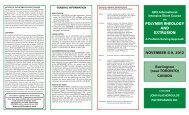The Role of Rheology in Polymer Extrusion - Polydynamics, Inc.
The Role of Rheology in Polymer Extrusion - Polydynamics, Inc.
The Role of Rheology in Polymer Extrusion - Polydynamics, Inc.
Create successful ePaper yourself
Turn your PDF publications into a flip-book with our unique Google optimized e-Paper software.
<strong>The</strong> usefulness <strong>of</strong> this rule, which holds for most polymers, is that while steady measurements <strong>of</strong><br />
shear viscosity are virtually impossible above 5 s –1 with rotational <strong>in</strong>struments, the dynamic<br />
measurements can easily be carried out up to 500 rad/s (corresponds to = 500 s –1 ) or even<br />
higher. Thus, the full range <strong>of</strong> viscosity needed <strong>in</strong> extrusion can be covered.<br />
Some typical results <strong>in</strong>volv<strong>in</strong>g narrow and broad molecular-weight-distribution samples<br />
are shown <strong>in</strong> Figure 1.9. <strong>The</strong> relative behavior <strong>of</strong> G versus can be used to identify whether a<br />
sample is <strong>of</strong> narrow or broad molecular weight distribution [6]. In fact, from the "crossover<br />
po<strong>in</strong>t" where G = G, it is possible to get a surpris<strong>in</strong>gly good estimate <strong>of</strong> the polydispersity<br />
M w /M n for PP [10].<br />
1.5 Constitutive Equations<br />
<strong>The</strong>se are relations between stresses and stra<strong>in</strong>s (deformations). In its simplest form, the<br />
Newtonian equation is<br />
where is viscosity and = du/dy, the shear rate.<br />
fluid<br />
For a shear th<strong>in</strong>n<strong>in</strong>g material <strong>of</strong> the power-law type, we have<br />
where m is consistency and n the power-law exponent.<br />
= <br />
(1.31)<br />
n-1<br />
n<br />
= = m = m <br />
(1.32)<br />
However, the above expressions, when <strong>in</strong>serted <strong>in</strong>to the equation <strong>of</strong> conservation <strong>of</strong><br />
momentum, cannot predict viscoelastic effects such as normal stresses, stress relaxation or<br />
extrudate swell. <strong>The</strong> simplest way to develop viscoelastic constitutive equations is to comb<strong>in</strong>e a<br />
model for an elastic solid<br />
with that for a Newtonian fluid<br />
= G <br />
(1.33)<br />
solid<br />
= <br />
flui d<br />
(1.34)<br />
By differentiat<strong>in</strong>g Equation 1.33 and add<strong>in</strong>g the two stra<strong>in</strong> rates, we get<br />
or<br />
<br />
+ = <br />
G <br />
(1.35)<br />
15




